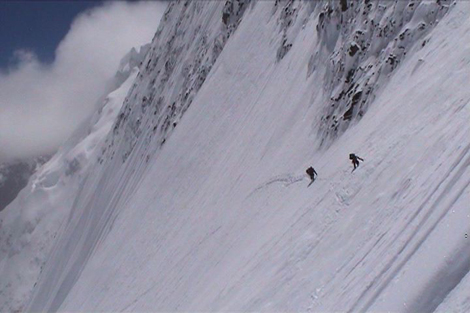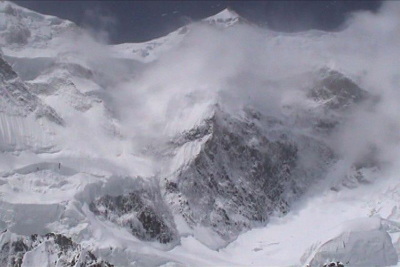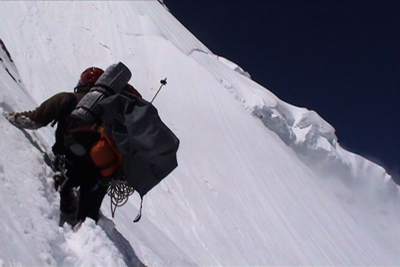Passi di Quiete
Marco Chiodi, Passi di Quiete (Peace Steps), video, 04:34, 2009, © comitato Ev-K2-CNR
Questo video è la documentazione sintetica dell’impresa alpinistica sulla montagna Gasherbrum II avvenuta nel giugno 2007, quando tre alpinisti, Karl Unterkircher, Daniele Bernasconi e Michele Compagnoni, andarono in Karakorum (Pakistan) per salire la montagna, alta 8647 m s.l.m., dal suo lato ancora inviolato, la parete Nord. Due di loro riuscirono a raggiungere la cima, mentre Compagnoni abbandonava il tentativo, fermandosi a 7000 metri di altezza, a causa di un malore. Essendo una parete dove mai nessun uomo aveva messo piede, i tre alpinisti si trovarono di fronte il compito di dover pianificare la salita e quale linea della montagna scegliere per raggiungere la cima. Questo, in gergo alpinistico, si chiama “aprire una nuova via”. Dalla partenza al campo base fino alla vetta, ogni passo o bracciata compiuta sulla parete è stato un piccolo, ma fondamentale, superamento del limite. Le immagini, che sono state realizzate dagli stessi alpinisti, appartengono all’archivio del Comitato Ev-K2-CNR, il quale ha promosso e organizzato l’impresa. Queste immagini cercano di trasmettere allo spettatore il senso di fatica e di finitezza provati dagli alpinisti durante la scalata. La roccia e la montagna di ghiaccio, con il cielo limpido di quei giorni rendono il paesaggio in cui si trovano gli alpinisti sublime, nel verso senso del termine: questo luogo attrae e spaventa simultaneamente. Molti alpinisti muoiono durante le spedizioni alpinistiche. L’opinione pubblica, non avendo una risposta logica, si domanda quale sia il motivo che spinge l’uomo a compiere certi gesti mettendo a rischio la propria vita. Quando a inizio secolo chiesero a Hermann Buhl cosa spinge gli uomini a voler scalare l’Everest, lo scalatore austriaco rispose semplicemente: “perchè l’Everest esiste”.
This video is the summary documentation of the mountaineering expedition Gasherbrum II in June 2007, when three climbers, Karl Unterkircher, Daniele Bernasconi and Michele Compagnoni, went to Karakorum (Pakistan) to climb the mountain, 8647 meters high above sea level, going for its side still untouched, the North Face. Two of them managed to reach the top, while Compagnoni abandoned the attempt, stopping at 7000 meters high, due to an illness. Being a wall where no man had ever set foot, the three mountaineers were faced with the task of having to plan the ascent of the mountain and choose which line to reach the top. This, in climbing parlance is called “open a new route.” From start to base camp to the summit, each step or stroke made on the wall was a small, but crucial, limit exceeded. The images, which were made by the climbers themselves, belong to the archive of the Comitato Ev-K2-CNR, who has promoted and organized the expedition. These images try to convey to the viewer the sense of effort and finiteness tested by climbers during the ascent. The rock and the ice, with clear skies make the landscape of those days where the climbers were, sublime in the true sense of the word: this place attracts and rejects simultaneously. Many climbers die during the expeditions. The public wonders what the motive that prompts man to do certain acts endangering their lives, having no a logical answer. When a journalist asked at the beginning of the century to Hermann Buhl what drives men to want to climb Mount Everest, the Austrian climber simply replied, “because Mount Everest exists.”
Still frames the video. From top left clockwise: Gasherbrum II face north, Karl Unterkircher, Daniele Bernasconi, Michele compagnoni
About admin:
Leave a Reply





